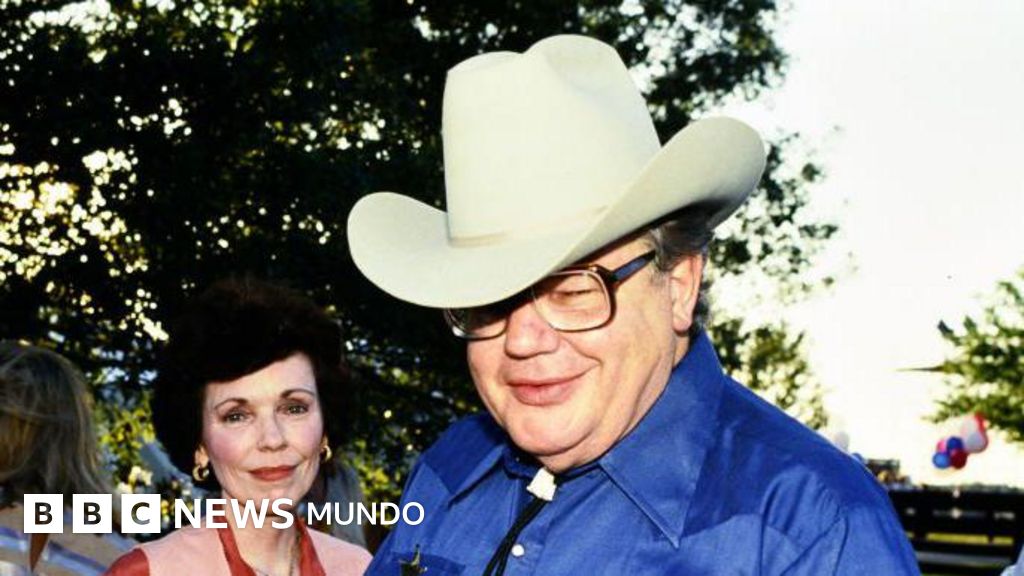
image source, Paul Harris/Getty Images
-
- author, Cecilia Barrier
- author title, BBC News World
They now have almost all the money in the world.
The Hunt brothers, members of a billionaire family thanks to their oil wealth, became famous for carrying out one of the largest price-fixing operations in U.S. history.
His father, Haroldson Lafayette Hunt, went into business operating a cotton plantation in Arkansas, but contemporary accounts indicate that the gambling business was one of the driving forces that got him off the ground.
He quickly entered the oil business and eventually became one of the richest people in the country. The tycoon, who was criticized for unscrupulous business operations and inspired the creation of one of the characters in the TV series “Dallas,” espoused white supremacist ideas and used the media to promote far-right ideas.
Hunt had 14 children, three of whom were involved in financial scandals related to speculation in the price of silver, a mineral they hoarded to such an extent that they had more reserves in their vaults than many countries.
Nelson Bunker, William Herbert, and Lamar were the three brothers involved in the metal scandal, nicknamed by critics the “Silver Gang.”
The most prominent of these was Nelson Bunker, who became one of the richest men in the world thanks to his business in Libya’s giant oil fields, which were nationalized by ruler Muammar Gaddafi in 1973.
According to William L. Silver, author of “The Silver Story,” Mr. Bunker’s obsession with silver was born precisely in 1973, when Gaddafi seized oil wells.
Mr. Bunker, an owner and producer of thoroughbred racehorses and an ardent anti-communist, was concerned about the inflationary spiral in the United States and decided to look for other ways to preserve his wealth to prevent his money from losing its purchase value.
Along with brothers William and Lamar, the trio began accumulating metals to protect themselves from market fluctuations and amassing vast wealth with the assets they sought to control.
Global Bullion Suppliers (GBS) said they bought tens of millions of ounces of the metal, some of it from Texas ranches guarded by armed workers and transported to Switzerland on planes designed specifically for the purpose.
By accumulating bullion and buying “futures contracts” based on the price of the metal, demand for silver caused the price to rise significantly.
They not only used their wealth to acquire more silver; The brothers took on large amounts of debt to continue growing their business.
silver rush
Hunters began purchasing the metal in late 1973, when the price of the metal was only about $3 an ounce.
Much of the operation takes place through these future contracts, which serve as legal agreements between two parties that promise to exchange an asset (called the underlying asset), either physical (such as silver or agricultural products) or financial, at a set date and price in the future.

image source, Bettman/Getty Images
“Silver seemed safer than offshore oil interests, and precious metals were a good hedge against paper money,” Bunker told Time magazine in January 1980, during the heyday of precious metals.
It is unclear exactly how many million ounces the Hunt family accumulated, but some reports from the time indicate that their wealth exceeded the metal’s annual production.
By the end of 1979, the Hunts family owned approximately 40 million ounces of physical silver and more than 60 million ounces in silver futures contracts, according to some estimates. Of the three brothers, Lamar, the youngest, seems to have held the most modest position.
They are believed to control two-thirds of the silver contracts traded on the New York Mercantile Exchange (COMEX) and one-third of non-governmental silver reserves. In one year, the value of the metal has increased by nearly 700%.
Hunts has secured international partners to further expand its operations, including members of Saudi Arabia’s elite.
In the midst of the frenzy, grandmothers also sold silverware and jewelry.
As word spread about the Hans’ trade, other investors tried to ride the wave by buying the metal.
The time was the silver rush of 1979.
The price soared so high that on January 17, 1980, it reached a historic record of $50 per ounce.
At the time, it was said that Hunts had “taken over” the silver market.
The price per ounce of precious metals rose from US$11 in September 1979 to US$50 in January.
But some people won, and some people lost.
The situation became so complicated for Tiffany’s jewelry store that the company placed an advertisement in a magazine. new york times indirectly attacked the Hunt brothers as being responsible for soaring metal prices.
Kodak, which relied on silver to make photographic film, was also greatly affected.
The success of the Hans’ business aroused the suspicions of U.S. authorities for monopolistic behavior and market manipulation.

image source, Bettman/Getty Images
The COMEX exchange announced “emergency rules” regulating the buying and selling of metals in January, and the Chicago Commodity Exchange Commission (CBO) halted the issuance of new contracts.
The new rules have increased so-called “margin requirements,” or the amount of collateral investors need to support their businesses.
Silver prices began to fall.
The banks and securities companies that had lent the brothers huge sums of money demanded cash to protect themselves, but the brothers didn’t have it.
The Hunt family initially refused to sell the silver for fear of causing panic, but was unable to meet new requirements set by silver market regulators and pressure from creditors.
On March 25 of that year, the brothers’ major financial provider, the Bacche Group, began selling its silver holdings to recoup some of its losses.
Finally, panic gripped the market.
On March 27, 1980, the metal dropped to $10 an ounce, a day remembered in history as “Silver Thursday.”
In this way, the Hunt family went from being one of the richest people in the world to being one of the most indebted.
hunt trial
The trial began after the debacle. Eight years passed before the Hunt brothers were convicted of conspiracy, manipulation, monopolization, racketeering and fraud in August 1988, according to a study published in the journal Economics, “The Silver Crisis Revisited.” commodity market journal.
The media at the time reported details of the trial.
“Texas’ flamboyant Hunt brothers, whose combined assets totaled $6 billion, have been sentenced,” the newspaper reported. Los Angeles Times August 21, 1988.

image source, Bettman/Getty Images
The paper explains that not all Hunts were convicted of the same crime.
The article notes that while Nelson Bunker and William were found guilty of extortion, there were no criminal penalties because the judgment was a civil judgment, noting that the three brothers violated fraud, merchandise and antitrust laws.
Only Mr. Lamar, owner of the Kansas City Chiefs football team, was acquitted of organized crime charges.
The jury also found that International Metals Investment Company and Mahmoud Hustok, a prominent racehorse owner, participated in the conspiracy.
The metals investment company was owned by two Arab sheikhs and the Hunt brothers, and Fatouq was the brother-in-law of Saudi Arabia’s crown prince, it added.
The Hans denied the charges, claiming that global political events drove up the price of silver.
The plaintiff in this case was Peru’s state-run mining company, Minpeco.
The company sued the Hunts for monetary damages, and after six days of deliberations, a New York jury ordered the defendants to pay the Latin American company more than $130 million.
Still, the brothers did not go bankrupt because their trust, which controlled the family’s oil company, was not affected by the lawsuit.
The Commodity Futures Trading Commission (CFTC) fined the brothers $10 million each and banned them from operating in U.S. commodity markets.
Additionally, regarding the issue of tax debt, an agreement was reached to repay taxes, penalties, and interest to the Internal Revenue Service.
While this was happening in the silver market, the brothers’ oil investments collapsed when oil prices fell in the 1980s.
Amid financial difficulties, the Han family filed for corporate bankruptcy in 1986 and personal bankruptcy in 1988.
Despite all the scandals, the Hunt family maintained investments in numerous industries. The heirs remain involved in the energy sector, own vast real estate portfolios and maintain an interest in the American football team.

image source, Getty Images

Don’t forget that you can also receive notifications in the app. Please download and activate the latest version.



